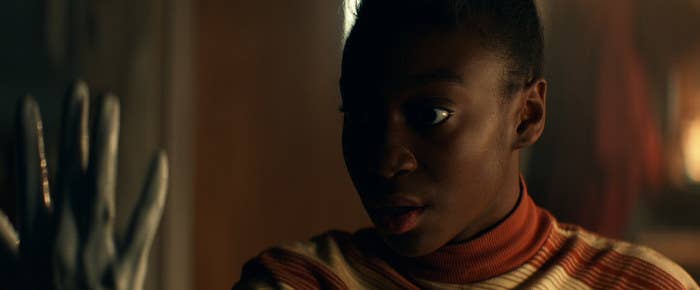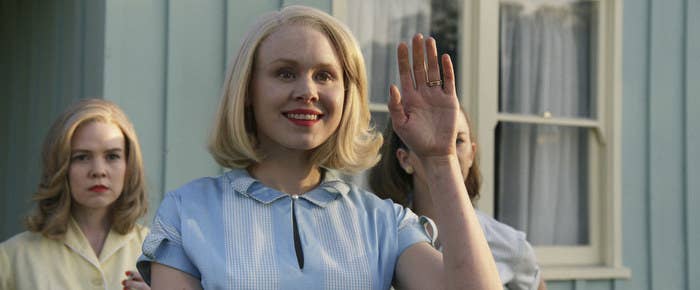
Last Monday, the trailer for Amazon’s new horror anthology series, Them, debuted. Almost immediately, the 10-episode season, which will premiere April 9, was met with criticism.
In the two-minute trailer, traumatic clips appear in quick succession: White students make ape sounds at a young Black girl, someone places golliwog dolls across a Black family’s lawn, and a revolting minstrel character flashes a devilish smile on a black-and-white television screen.
Twitter users quickly lambasted the teaser. “These directors, writers and producers love shopping around black trauma for reactions and sales. Just one light hearted movie would do but no we’re expected to sit through this,” read one tweet. “This is ‘trauma porn’ and adds a sense of dramatization, or fiction, to events black people actually experience,” read another.
Though there were moments that gave me pause, I wanted to check out the show for myself. And after watching the show in its entirety, I feel confident saying that Black Twitter was right about this one. Them is a bloated series that repackages some of the worst evils ever committed to Black people in the United States for entertainment — and it does so with little to no depth about their implications, an approach that seems to be part of an unfortunate growing trend in Hollywood. Because the series features a Black cast as its focal point, it was going to be viewed through a specific lens no matter what. But in attempting to combine real historical trauma with a metaphysical component, Them ultimately dilutes itself, relying too heavily on real-world issues that never authentically gel with the story being told. The show is definitely horror, but the only viewers who may be scared, possibly even traumatized, are Black people.
Created by first-time showrunner Little Marvin and executive produced by Lena Waithe, the 1950s-set series begins with the Emorys. Henry (Ashley Thomas), Lucky (Deborah Ayorinde), Ruby (Shahadi Wright Joseph), and Gracie (Melody Hurd), are a Black family who move from North Carolina to California. In search of a better life, they settle in an all-white neighborhood located in East Compton. Within 10 days, their lives are turned upside down by paranormal forces within the new home, as well as the overt racism of their white neighbors.
On its face, this seemed like an interesting premise. Immediately I thought about A Raisin in the Sun, the 1959 play by Lorraine Hansberry that ends with a Black family from Chicago’s South Side making the decision to move to an all-white neighborhood. We don’t know what happened to that family, because the play ends before the move, though you can surmise — because of American history — that their time was anything but pleasant. Them explores similar themes, but its execution is facile.

Take the character of Betty (Alison Pill), one of the main antagonists. Betty feels threatened by the family’s presence in her once-lily-white neighborhood and employs mean-girl tactics to get all the other housewives to make the Emorys feel as unwelcome as possible. In one scene, a group of white women posts up in front of the Black family’s lawn, blasting the song “Civilization (Bongo, Bongo, Bongo),” meant to emphasize the point that the Emorys don’t belong. In another scene, the same women make crude comments about the family and lob a slew of racist remarks at them. “Niggers are actually colored people,” says one of the housewives, a pregnant woman named Nat (Abbie Cobb), making a joke about what “NAACP” stands for. “Didn’t you see how exhausted she was when they got here?” Betty says afterward, referring to Lucky, the matriarch of the Emory family. “How can you tell if colored people look tired or not?” Nat asks.
The show is definitely horror, but the only viewers who may be scared, possibly even traumatized, are Black people.
I would not expect anything more than trite and unfunny assertions from people like this. These hackneyed insults from characters modeled after garden-variety racists were par for the course during this time in American history. But the issue with Them is that it never gets more interesting than that. And a potentially thoughtful examination of the structural anti-Black racism of the housing market and its effects on Black people gets sidelined for run-of-the-mill white hate. As Soraya McDonald wrote in a piece for the Undefeated last year about the pitfalls of shows that see themselves as “advancing radical racial politics,” like HBO’s Lovecraft Country, the villains are essentially two-dimensional: “The big bads in Antebellum and Lovecraft Country ... are filmic paper tigers — standard-issue evil white people who feel too one-note to engender any emotional investment in their demise. They aren’t so much characters as a collection of tropes. Their racism seems as much a casual choice as their taste for cheap dye jobs.”
That’s what viewers get with Them: a stale retelling of how race operates in the US. Although there are supernatural elements at play — many of which were so convoluted I really did not understand what was going on — this kind of terror takes a backseat to the explicit racism, which operates, unoriginally so, as the real horror. Henry, a WWII veteran who has PTSD, battles the inequalities of being a Black man in the workforce, simultaneously undervalued and held to a higher standard than his white colleagues. Lucky deals with insecurity about motherhood, which are exacerbated by her interactions with her white neighbor. Ruby struggles with being the only Black girl in the school, a feeling that soon devolves into self-hate, and Gracie, the youngest daughter, faces a problem most common in the horror genre: seeing specters that her parents can’t see.
In several instances, the show seems to think it’s going for depth when in reality it’s just reinforcing trauma. There’s a scene of such gratuitous violence that I considered turning it off because it was the clearest indication that the show conflates Black trauma with horror. The shocking moment lazily combines two torturous events happening simultaneously. It's a cheap way of pushing the plot forward and unnecessarily dumps even more grief onto the Black family. Soon after, the white characters who commit the crimes disappear, with no explanation of their reasoning for acting in such a manner.
Them is not the only new TV show or film that seemingly traffics in Black trauma. Two Distant Strangers, a forthcoming Netflix film written and directed by Travon Free, who is Black, received similar pushback when its trailer was released earlier this year. The premise is that a Black man is having the “best day of his life,” that soon becomes the “worst” when he leaves a hookup and gets into an altercation with a cop. In the trailer, this is a setup for a Groundhog Day sort of vibe, where the character essentially repeats this trauma over and over. I can’t speak to Free’s film; I haven’t seen it. There’s a slightly icky feeling to the marketing, however. Because stories of police brutality are so commonplace in the news, it’s understandable that people want to make projects that speak to the moment. But it’s a delicate balance; as the trailer rollout demonstrated, it can ultimately feel like Black pain is being regurgitated for capitalistic means. “If you watch it first I'm willing to bet you'll feel differently,” the director tweeted to someone who ragged on the trailer. “Given that subversive storytelling can't be given away in a trailer.”
Black creatives should be able to express themselves, but there should also be consideration for how images of our trauma are essentially a hot commodity right now.
It’s a complicated conversation. Black creatives should be able to express themselves and create fulfilling work, but there should also be consideration for how images of our trauma are essentially a hot commodity right now. “I am tired. I am tired of pop-cultural artifacts that render Black people as merely Black bodies onto which the sins of this ragged country are violently mapped,” wrote critic Angelica Jade Bastién for Vulture last year after the release of Antebellum starring Janelle Monáe. “I am tired of suffering being the primary lens through which we understand Black identity. I am tired of being so hungry for Black joy and Black representation that scraps feel like a meal.” After the success of Get Out, Us, Watchmen, and the like, it’s unsurprising that networks and streaming services are salivating for the next great project that will be praised for its interrogation of race in America. However, because there simply aren’t enough Black projects to balance the bad, it stings when movies like Antebellum or shows like Them get financing. In attempting to be great art, or even just good entertainment, projects like these rely on harsh violence without any satisfying exploration of characters who endure unimaginable pain.
To sprinkle in a few positives, I will say that Them stuns visually, especially the first episode. The vivid colors of mid-19th-century America really pop and draw the viewer in, and Mari-An Ceo’s costume design work is impeccable. For what it’s worth, the show is well acted, with moments of wry humor that, while rare, were certainly very much appreciated. Unfortunately, while it’s gorgeous, Them has nothing new or interesting to say. The show has already been picked up for a two-season order, so maybe the next season, which will have a different premise, will be better. But if I were you, I’d stay far away from Them. ●
